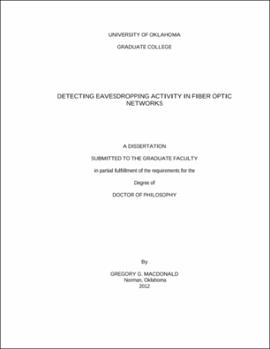| dc.contributor.advisor | Sluss, James | |
| dc.creator | MacDonald, Gregory | |
| dc.date.accessioned | 2019-06-05T21:19:57Z | |
| dc.date.available | 2019-06-05T21:19:57Z | |
| dc.date.issued | 2012 | |
| dc.identifier | 99673609602042 | |
| dc.identifier.uri | https://hdl.handle.net/11244/320287 | |
| dc.description.abstract | The secure transmission of data is critical to governments, military organizations, financial institutions, health care providers and other enterprises. The primary method of securing in-transit data is though data encryption. A number of encryption methods exist but the fundamental approach is to assume an eavesdropper has access to the encrypted message but does not have the computing capability to decrypt the message in a timely fashion. Essentially, the strength of security depends on the complexity of the encryption method and the resources available to the eavesdropper. The development of future technologies, most notably quantum computers and quantum computing, is often cited as a direct threat to traditional encryption schemes. It seems reasonable that additional effort should be placed on prohibiting the eavesdropper from coming into possession of the encrypted message in the first place. | |
| dc.description.abstract | One strategy for denying possession of the encrypted message is to secure the physical layer of the communications path. Because the majority of transmitted information is over fiber-optic networks, it seems appropriate to consider ways of enhancing the integrity and security of the fiber-based physical layer. | |
| dc.description.abstract | The purpose of this research is to investigate the properties of light, as they are manifested in single mode fiber, as a means of insuring the integrity and security of the physical layer of a fiber-optic based communication link. Specifically, the approach focuses on the behavior of polarization in single mode fiber, as it is shown to be especially sensitive to fiber geometry. Fiber geometry is necessarily modified during the placement of optical taps. | |
| dc.description.abstract | The problem of detecting activity associated with the placement of an optical tap is herein approached as a supervised machine learning anomaly identification task. The inputs include raw polarization measurements along with additional features derived from various visualizations of the raw data (the inputs are collectively referred to as "features"). Extreme Value Theory (EVT) is proposed as a means of characterizing normal polarization fluctuations in optical fiber. New uses (as anomaly detectors) are proposed for some long-time statistics (Ripley\'s K function, its variant the L function, and the Hopkins statistic). These metrics are shown to have good discriminating qualities when identifying anomalous polarization measurements. The metrics have such good performance only simple algorithms are necessary for identifying modifications to fiber geometry. | |
| dc.format.extent | 113 pages | |
| dc.format.medium | application.pdf | |
| dc.language | en_US | |
| dc.relation.requires | Adobe Acrobat Reader | |
| dc.subject | Eavesdropping | |
| dc.subject | Fiber optics | |
| dc.subject | Optical communications | |
| dc.title | DETECTING EAVESDROPPING ACTIVITY IN FIBER OPTIC NETWORKS | |
| dc.type | text | |
| dc.type | document | |
| dc.thesis.degree | Ph.D. | |
| ou.group | College of Engineering::Department of Engineering | |
